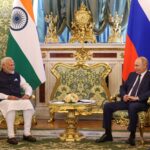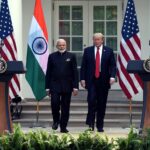A recent Congressional Research Service (CRS) report on U.S.-India relations underscores that both the Trump and Biden administrations have identified India as a “crucial partner,” in the U.S. Indo-Pacific strategy.
The report highlights the role of the Quadrilateral Security Dialogue, or “Quad,” which includes Japan and Australia, as a key multilateral mechanism since 2017. It also notes the personal rapport between former President Donald Trump and Indian Prime Minister Narendra Modi.
Critical Emerging Technologies and Defense Cooperation
On technological collaboration, the CRS report emphasizes the Initiative on Critical and Emerging Technologies (iCET), launched in May 2022, which fosters cooperation on space, clean energy, semiconductor supply chains, artificial intelligence, and quantum computing.
“Many analysts see shared unease about China providing the context. Since June 2023, the iCET has included a new India-U.S. Defense Acceleration Ecosystem (INDUS-X) to facilitate defense technology and industrial cooperation between the U.S. and Indian governments, businesses, and academic institutions,” the report added. “ICET is overseen by the two countries’ National Security Councils. A key question is the extent to which the second Trump Administration will be willing to share advanced U.S. technologies with India.”
Regarding defense ties, the report highlights that analysts have described defense cooperation as the “load-bearing pillar” of the U.S.-India strategic partnership. It notes that major defense sales exceeding $20 billion since 2008 are ongoing, and large-scale joint military exercises across all services have become routine, with a focus on interoperability and maritime security.
Trade and Economic Relations
The CRS report indicates that over the past decade, U.S.-India trade and investment have grown, though the U.S. has consistently faced trade deficits with India. Under the Biden administration, both countries have worked on trade-related issues, including technology, supply chains, and agricultural market access, but frictions remain over tariffs and trade restrictions.
“An open question is what direction trade ties will take in President Trump’s second term. In a call with PM Modi, the President called for ‘moving toward a fair bilateral trading relationship.’ The President has called India the “tariff king” due to its high tariffs,” the report added. “He has also threatened to apply 100% tariffs against the BRICS (Brazil, Russia, India, China, and South Africa), if those countries move to displace the U.S. dollar with a proposed BRICS currency.”
Additionally, the report mentions Trump’s past tariff hikes on Canada, Mexico, and China, suggesting that similar measures could pose risks for India.
Immigration and Workforce Concerns
The report highlights that Indian nationals account for more than two-thirds of H-1B visa issuances and consistently represent the largest group of permanent employment-based immigrants.
“Congress has considered reforming the H-1B program; some observers express concern that hiring through the program displaces U.S. workers, while others argue that U.S. employer demand for H-1B nonimmigrant workers reflects a lack of qualified U.S. workers and that limited visa availability is a problem for U.S. competitiveness,” it states.
India’s Strategic Autonomy and Relations with Russia
The CRS report underscores that India’s deep ties with Russia reflect its commitment to strategic autonomy. It highlights that New Delhi’s neutral stance on Russia’s 2022 invasion of Ukraine has caused concern among U.S. officials, including members of Congress.
The report notes that Indian imports of Russian oil surged 16-fold by the end of 2022, with Russia supplying about 25 per cent of India’s imported oil in the 2023/24 fiscal year. Additionally, Russia remains India’s primary supplier of defense equipment, though India is diversifying its sources.
Security Concerns and Democratic Trends
In 2023, the U.S. and Canadian governments alleged Indian involvement in two assassination plots targeting Sikh separatists in North America. The Biden administration has called for accountability, and some members of Congress have voiced concerns that the issue could strain U.S.-India relations.
“The Indian government—which views overseas Sikh separatists as a national security threat—reportedly is undertaking a broader campaign of transnational repression (TNR) against the Sikh diaspora,” the report states.
The CRS report also notes concerns over India’s democratic trajectory, stating that since PM Modi’s 2014 electoral victory, signs of “democratic backsliding and creeping autocracy,” have been observed. However, it acknowledges that opposition parties performed well in the 2024 national elections.






